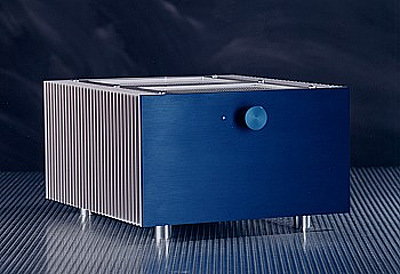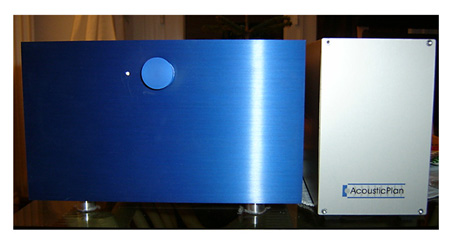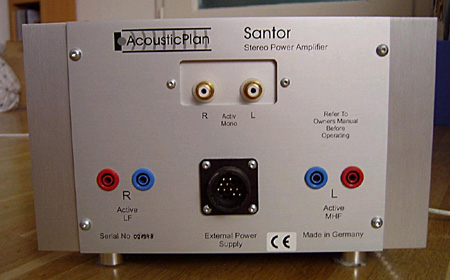
You are reading the older HTML site
Positive Feedback
ISSUE
23
january/february
acousticplan
Santor amplifier
as reviewed by Brad Morrical

|
BRAD MORRICAL'S SYSTEM
LOUDSPEAKERS
ELECTRONICS
SOURCES
CABLES
ACCESSORIES |
Hybrid amplifiers, though unusual, seem to be gaining in popularity, particularly integrated hybrids. Why do designers create hybrid amps? After all, a hybrid design requires detailed knowledge of both solid state and vacuum tube circuitry, and the two technologies are not necessarily compatible. Still, tube and solid state amplifiers tend to sound different. Each technology has its strengths and weaknesses, and it must be the lure of a bridge between the speed, power, and ease of use of solid state and the harmonic completeness, dynamic contrast, and sheer presence of tube gear that tempts engineers to create a happy marriage between the two. The AcousticPlan Santor is a hybrid amplifier that attempts this synthesis of sound in the simplest possible manner, with a large dose of clever thinking and with attention to the details of good engineering and construction.
You might be asking, "If transistors can do voltage amplification okay and current amplification great, why bother with tubes?" This is a good question, and one that is best answered by listening. For many people (myself included), tube circuits do a superior job of preserving the tone and texture of recordings. The most subtle microdynamic and low-level information is preserved, resulting in a less electronic-sounding component. Why is that so important? Tone is one of the primary means by which musicians express themselves, and it is critical to the character of an instrument. In my opinion, tone has been given short shrift in high-end audio for the past twenty years. The pursuit of more and more resolution, transparency, speed, dynamics, and neutrality has sent tone to the back of the bus. This can be readily heard in many so-called high-end amplifiers. The revival of SET amps, and tubes in general, is (in part) a backlash against the sterile, toneless gear we've been hearing since the 1970s. Even today, a lot of highly touted gear does not reproduce instrumental tone correctly.
Let me state my position: If a piece of audio equipment cannot correctly reproduce the tone and timbre of an instrument, and cannot sustain that tone and timbre throughout the instrument's decay, that piece of equipment is not true hi-fi, despite its other positive attributes. I am not saying that tone and timbre are the most important aspects of sound reproduction, but simply that you cannot have high-fidelity sound reproduction without correct tone, timbre, and decay. Those of you who favour attack and slam should ask yourselves this important question: Why do rare musical instruments like Stradivarius violins fetch millions of dollars? What makes one instrument more valuable than another? For the most part, the reason is the tone that the instrument is capable of making. I have heard many rare violins during the last three years, and can attest to the incredible part that the sonic character of an instrument plays in the interpretation and enjoyment of music. My exposure to these incredible instruments has led me to reprioritize my musical values. It has made me realize that capturing the complexity and subtlety of the tone of these instruments is a key part of preserving realism in music reproduction.
Beautiful tone is a highly prized attribute in live performance. Many musicians work a large portion of their professional lives to perfect their tone, in an attempt to put their personal stamp on the music. Why, then, should we allow out hi-fi gear to bleach or strip away subtleties of tone, in effect destroying some of the meaning of music? The effect is so prevalent that unless you frequently attend live events, you may not even realize what you are missing.
How does the need for proper tone and timbre reproduction apply to hybrid amplifiers? There is an implicit assumption that adding tubes to the circuit will allow an amplifier to address the aspects of tone that are missing in most solid-state amplifiers. The German-made AcousticPlan Santor is an unusual design for a several reasons. First, it uses tubes for voltage gain and MOSFETs to deliver current to the speakers. Second, it is very compact, given the design and high bias of the output devices. Third, it uses only two stages of amplification. Finally, it uses no feedback of any kind, either global or local.

The Santor has a power rating of 50 watts into 8 ohms and 100 watts into 4 ohms. While it is no powerhouse, it can deliver a significant amount of current into low-impedance loads. The input gain stage uses four 6922 tubes in parallel per channel in order to provide sufficient drive for the output MOSFETs. When I asked Claus Jäckle, the owner and chief designer of the company, why he used so many tubes, he replied that it was necessary with these particular MOSFETs in order to overcome their high input capacitance. Paralleling the tubes lowers the output impedance and gives greater current drive, and Claus is opposed to using a cathode follower, the device usually employed to achieve these results. He feels that a cathode follower adds unnecessary complexity (and a third active stage). The MOSFET output stage is relatively conventional. According to Claus, it merely supplies the current, and adds nothing to the sound.
The appearance of the Santor is also unusual. The front panel is a thick piece of blue anodized aluminum with an aluminum on/off knob anodized in the same color. There are no other adornments on the faceplate, with the exception of a bright blue LED above the power knob. The aesthetics are aided by the diminutive size of the amp, which is brought about by placing the power transformer in a separate, plain aluminum box that is connected to the amp by a locking umbilical cord. I think the amp looks handsome and unobtrusive. Its build quality is superlative, and the amp performed flawlessly during the time I had it.
The top plate is also aluminum, with large cutouts covered by metal mesh. I assume this is to help keep the inside parts a bit cooler (with eight 6922s, things do get a bit toasty). The sides consist of decent-sized aluminum heat sinks, but the amp still gets hot. Based on the heat it generates, I initially assumed that the amp was either pure or partly class A, as it is easily the hottest-running amp I have had in my house, this side of a SET!
There is an extended turn-on sequence that takes a couple of minutes. After about a minute, you hear a relay click and a green LED inside the amp glows green. After about another minute, there is a second click, and a second LED glows green. At this point, the amp un-mutes, and is ready to play music. It reaches a pretty stable temperature after about thirty minutes, but takes about an hour to sound its best. I didn't worry about break-in because Claus told me the amp he sent me was one he has used personally. In fact, I perceived no sonic changes during my rather lengthy audition period.

Because of the Santor's current ability into a 4-ohm load, I did not anticipate that it would have problems driving my Apogee Caliper Signatures when I substituted it for my reference amp, the Sphinx Project 14MkIII (also a hybrid). In spite of what you might think, the Caliper Signatures are not difficult to drive, if the amp is stable into a low-impedance load. The little AcousticPlan was able to exercise reasonably good control over the Apogees. It had a beautiful way with tone that reminded me of the Cary CAD 572se monoblocks that I used to own, but with a less identifiable character. The Santor has the beautiful tone of an SET amp, but it does not sound overly lush, it does not round transients, and it does not truncate the frequency extremes, as do many pure tube designs. It is very transparent, and its low-level resolution resolution and microdynamics equal those of a very good SET. In its lack of coloration, and its concurrent ability to render a full tonal palette, the Santor is similar to a good OTL amp, missing only a bit of the effortless liquidity of the best OTLs.
The Santor renders tonal color very naturally, without exhibiting any audible manipulation. Listening to music through this amp is like looking at a diamond. The first sensation is that it is almost supernaturally transparent and colorless. The Santor allows you to hear very deeply into the music, but just as light hitting a diamond produces a rainbow of colors, the amplifier sparkles and has an internal glow. The AcousticPlan amp is transparent and clear, yet it can render all of the tonal color in a recording without seeming to editorialize. It does not have the dry, somewhat sterile sound that most solid-state amps possess, nor does it sound overly ripe, like many high-powered push/pull tube amps. It treads the middle ground with grace and finesse.
I was able to listen to the Santor for hours on end, without fatigue and without the niggling sensation that something was missing. After months of listening, the only weak aspect that I could perceive in the Santor's performance was in the upper bass, which was a bit lightweight with some material. Most of the time, however, the amplifier's timbre was finely balanced—neither dark nor light. This also indicates that the Santor has a uniform dynamic response across the frequency range.
Classical music benefited from the Santor's ability to handle its many complexities. This was particularly impressive when low-level musical threads could be heard, with the proper balance and attack, in the presence of much louder threads. Strings sounded very natural. When they were close-mic'ed, I could easily hear all of the bowing, fingering, and breathing, even the sounds of clothing swishing. If you listen to a violin being played from up close, you hear a lot of raspiness from the bow being dragged across the strings. With the Santor, strings never sounded remotely harsh, yet it reproduced their upper harmonics in an utterly natural fashion. Woodwinds were also very well served, with their distinctive characters convincingly rendered. Because of the Santor's remarkable low-level resolution, quiet passages were enjoyable, and it was easy to "get" the music.
The Santor's resolution and low-level detail also contributed to its ability to reproduce a correct acoustic. If the recording was dry and forward, the Santor made it sound dry and forward. It may have been embellishing slightly, as it rarely sounded unpleasant, but if the recording was made in a natural acoustic, I could clearly hear the back of the hall and could perceive its dimensions. Instrumental decay was very well preserved. Many in the SET amp camp claim that only SETs can preserve this kind of low-level information. They believe that it is impossible to match the two halves of a complementary design closely enough, and therefore that a push/pull amp will always smear low-level information. Having heard many of the best SET amps, I can say that just about every SET amp can do this one thing very well, and that most push/pull amps—tube or solid-state—cannot match an SET in this respect. However, I have heard a few non-SET amps that capture low-level information as well as a good SET, and that are not shackled by the weaknesses that afflict most SETs. I now add the AcousticPlan Santor to that list.
When I played jazz and rock music, the Santor was able to swing pretty well, but not quite as well as the Sphinx Project 14MkIII, which sounded a bit more organic and better sorted-out rhythmically. I think that the Santor's upper-bass leanness hampered it with this type of music, which needs a bit more power in this region. The Santor put in a fine showing with rock and jazz, but both the Sphinx and the Silvaweld amps beat the little AcousticPlan with the same recordings, as did my Spectral Acoustics class D amps (which, by the way, are WAY behind the Santor in overall sound quality).

Compared to the Sphinx, the Santor reaches a bit deeper into the recording, uncovering more musically relevant information. In this regard, it is on a par with the Silvawelds. The Santor's instrumental timbre is right on the money, as is its superb resolution of instrument decay. The Santor is capable of providing deep musical satisfaction without suggesting that it might be telling you sweet lies. I had an interesting experience with the Santor when I took it to a friend's place along with my Sphinx Project 14. My friend has a pair of Apogee Divas that have been upgraded with improved midrange and tweeter ribbons. He had a couple of all-solid-state amps that we compared to the little Santor—a Sphinx Project 18 and a Spread Spectrum Technologies Son of Ampzilla. After many hours of listening, we determined that the Santor was the most transparent and tonally correct amp of the four, with the two Project amps running a pretty close second. The Project 18 sounded the most powerful, and also had the highest power rating. It surpassed the Santor in this respect, with strong muscular sound, particularly in the bass, while the Santor lacked the slam and power to whip the big Divas around. Nevertheless, while the Project 19 sounded quite transparent and clear, it was not as good as the Santor at reproducing the tonal character of instruments or retrieving low-level information. The Son of Ampzilla sounded distinctly warm, smeared fine detail, and fell short in its rendition of spatial information. My friend and I agreed that it was clearly behind the other amps.
The AcousticPlan Santor has no major flaws, but it does have some small ones, as all amps do. Aside from the slightly leaned-out upper bass, its dynamics were not quite up to the unbridled standard set by my Silvaweld OTL Tube Reference or the Einstein "Final Cut" OTL that has deeply impressed me at hi-fi shows. Compared to the Sphinx Project 14MkIII, the AcousticPlan Santor is more tonally neutral, as it leans slightly to the warm side. Tube rolling has an unusually large effect on the sound of both of these amps, due to their lack of negative feedback. Changing tubes may not alter the fundamental character of an amp, but using different tubes in a no-feedback circuit can definitely push the amp toward a darker or lighter sound. It may be that some of the Santor's upper bass leanness was due to the JJ tubes provided by AcousticPlan, but because I did not have eight 6922s of the same brand, I was not able to determine this.
If I didn't already own the superb Silvaweld OTLs, I would seriously consider buying the Santor because, at least with classical music and most jazz, it holds a small but significant advantage over my Sphinx. I feel that the Santor tells more truth about what is on the recordings. With my other speakers, the Acoustat 1+1s (with medallion transformers and upgraded passive parts), the Santor gave a very lifelike presentation of jazz, orchestral and chamber music, and well-recorded rock. I was again surprised by how well the Santor drove speakers that are considered difficult loads. If you want an amp that can deliver subtlety and finesse without sacrificing grunt, the Santor may be the one! Brad Morrical
Santor
Retail: $5200 Euros
AcousticPlan
web address: http://www.acousticplan.de
